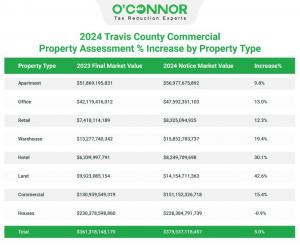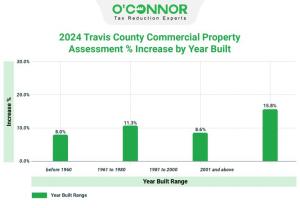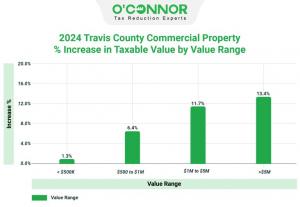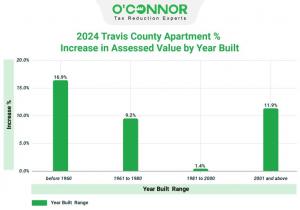
Travis Central Appraisal District 2024 Reappraisal
O'Connor has finalized an analysis for the 2024 Reappraisal conducted for the Travis Central Appraisal District.
AUSTIN, TEXAS, UNITED STATES, May 3, 2024 /EINPresswire.com/ -- Travis Central Appraisal District increased the total value of real estate in Travis County from $361 billion in 2023 to $379 billion for 2024, a 5% increase. The total value of houses in Travis County fell about 1% to $228 billion while the value of commercial property soared 15% from $131 billion in 2023 to $151 billion in 2024.
Divergence Between Residential and Commercial
Valuation trends for residential and commercial very sharply. While the overall value of residential properties in Travis County Fell about 1%, the median market value of a home value by Travis central appraisal district fell about 7%. Conversely, the value of commercial properties soared with the land incurring the sharpest increase at 42.6%.
Long Term Trends for Home Values in Travis County
Travis County home values increased at a mind boggling pace from 2011 through 2022 increasing 209% in 11 years, or 19% per year. The median home market value estimated by TCAD rose from $204,559 in 2011 to $632,208 in 2022. Few if any other major metro areas in the United States saw home prices increase at 19% a year over an 11-year-period.
However, it was a bubble that had to burst. After soaring 209% in 11 years Travis County home values fell 12.9% between 2022 and 2024 based on the median market values estimated by Travis Central Appraisal District. The median home price in Travis County estimated by the local appraisal district fell from $632,208 dollars in 2022 to $551,419 in 2024, a 12.9% decline.
Impact of Texas 10% Homestead Cap
Due to the homestead cap that limits property tax increases for Texas homeowners to a maximum of 10% per year for their primary residence, the appraised value or taxable value those lagged well below the market value as estimated by Travis Central Appraisal District. The taxable value of the median home in Travis County rose from $162,417 in 2011 to $401,806 in 2024, a 147% increase over 13 years. This works out, without compounding, to an 11% increase annually.
Many Travis County homeowners benefit from the homestead cap. While the median value of a home in Travis County is $551,419 for 2024 the median taxable value of such a home in Travis County is $401,806 or 27% less.
20% Circuit Breaker Cap for 2024, 2025 and 2026
The Texas homestead cap only applies to your primary residence. Second homes and rental homes do not benefit from the 10% homestead cap. However, for tax years 2024, 2025 and 2026 a 20% circuit breaker cap limits assessment increases for real estate valued at less than $5 million.
Given a large gap between the taxable value of Travis County homes at $401,806 and the market value of Travis County homes at 551,419 dollars the typical Travis County homeowner can expect to see a 10% increase in their annual property taxes even if the value of their property only increases slightly during the next three years.
Commercial Property Owners the with Higher Property Taxes as Values Plummet
Travis County commercial property owners are likely suffering from cognitive dissonance as they receive their 2024 notices of assessed value. Commercial real estate brokers who sell properties, mortgage bankers who arrange financing for commercial properties and the media are all reporting on severe adverse conditions in the commercial property market. Conversely, Travis Central Appraisal District is reporting a 15% increase in the value of commercial property in Travis County including both existing property and new construction.
Land owners are receiving property tax assessment notices with an average increase of 43% in Travis County. The increases in land value are puzzling since there are limited development opportunities in Travis County given the malaise in the commercial real estate industry. Apartment owners, facing headwinds from higher interest rates, higher operating expenses and flat revenue are receiving revaluation notices with increases of about 10%.
Are Commercial Property Values Increasing or Declining?
Most Texas appraisal districts, including TCAD, are reporting commercial property values are up sharply. Fort Bend Central Appraisal District increased the value of commercial real estate in Fort Bend County by 47% from 2023 to 2024. Conversely, Green Street, a recognized Wall Street advisory firm, reports that commercial real estate values are down 7% in the last year, down 21% since the peak in 2022 and have fallen back to levels last seen in late 2014. Their Commercial Property Price Index has fallen to levels last seen at the end of 2014.
Why the Large Decline in Commercial Property Values?
The simple model answer for the decline in commercial property values can be stated in three words: higher interest rates. The following chart summarizes the decline followed by the large increase in the 10-year-treasury rate, which is the interest rate most important to real estate investors.
Valuation of Commercial Real Estate
The market value of commercial real estate is basically a function of the net income generated by the property and the capitalization rate, or conversion rate. The higher the capitalization rate, the lower the value. Conversely, the lower the capitalization rate, the higher the value.
This is similar to how bonds are valued. The higher the interest rate, the lower the value of a bond. The lower the interest rate, the higher the value of the bond.
How are Capitalization Rates Determined
Capitalization rates are determined in the market based on transactions between buyers and sellers. Conceptually, the capitalization rate is the sum of an interest rate and a risk rate. The interest rate typically used for commercial real estate investors is the 10-year-treasury rate. The risk rate includes factors such as management risk, interest rate risk, market risk, and the risk of owning an asset for an extended period of time. (You can’t sell real estate in a day the way a stock can be sold instantly.)
What Other Factors are Impacting the Value of Commercial Real Estate?
Factors negatively impacting the value of commercial real estate in Austin TX include higher operating expenses including casualty insurance, property taxes and labor. The apartment market in Austin TX has excess supply and the office market is also suffering from excess supply. While rental rates had been increasing prior to 2023, revenue has flattened for most types of commercial real estate in Austin Texas. In addition to higher interest rates, lenders have imposed tougher underwriting standards, leading to lower loans. In many cases, owners with loans maturing are not able to secure a loan large enough to pay off the existing loan.
There are stories in the popular press at least weekly about large real estate investors walking away from institutional grade real estate because they can’t refinance the debt.
The confluence of higher interest rates, tougher underwriting standards by lenders, higher operating expenses and relatively flat revenue have led to a sharp decline in the market value for most types of commercial real estate in Austin TX. Commercial property owners will be appealing initial value notices sent by Travis central appraisal district in volume.
Commercial Tax Assessments Up Regardless of Year Built
There is no clear trend between year of construction and the level of property tax assessment increase for the revaluation by Travis Central Appraisal District. Interestingly enough, properties where tax roll data does not provide clarity on construction dates have gained the most marked change with values going up by close to 50%.
There is a positive correlation between the value strata and the magnitude of the property tax assessment increase for Travis County. Properties valued under $500,000 have the smallest level of increase while those valued over $5,000,000 have the largest amount of increase at 13.4%.
Outside of property lacking construction date details (listed as Others in the illustration), apartments built before 1960 had the largest level of property tax assessment increase estimated by TCAD for 2024. This may be doing part to a tighter rental market for older properties. It is also likely in part to new construction adding to the total value of buildings built after 2001.
Travis County Office Building Owners Likely to Become Apoplectic
The category of commercial property suffering the largest decline in value is undoubtedly office buildings. Travis County office building owners will be shocked and stunned to see large increases in 2024 property tax assessment notices considering the status and outlook for the office building market. The vacancy rate for Austin TX office space has been increasing since 2019. The total market for Austin office space includes 87.5 million square feet of space, of which 19.8 million square feet are vacant and another 11 million square feet are available for sublease. The stated vacancy rate for Austin’s office space is 22.6%. However, adding both the vacant space and the 11 million square feet available for sublease, there is 30.8 million square feet of space available in Austin TX, or 35% of the total existing office space.
Older Retail in Austin Incur Largest Assessment Increases
Older retail buildings in Austin Texas saw higher property tax assessment increases than newer buildings. The reasons are not clear. However, this may be partially related to older buildings having primer locations.
Austin Texas Warehouse Building Owners Get 20% Tax Increase
The Travis County industrial property market is in great shape compared to the office market. However, vacancy rates for industrial property in Travis County increased from 11% to 13% from Q4 22 to Q4 23. Owners of industrial buildings are facing many of the issues common to commercial property owners including higher interest rates, tougher underwriting standards, and higher operating expenses. A 20% tax increase will be a bitter pill to swallow.
All Categories of Austin Office Buildings Face Higher Property Taxes
Small Apartments Incur Highest Property Tax Increase
Owners of small apartments face the highest level of property tax assessment increase in Travis County Texas for tax year 2024. The occupancy rate for all Texas apartments has fallen off from 98% in 2021 to 93% in the first quarter of 2024. The lower levels of increase for mid-rise and high-rise apartments are probably accounted for by new construction adding to the total value and the soft rental market for new construction.
Retail Tax Assessments Rise in Travis County
Travis County owners of single-tenant retail buildings, strip centers and neighborhood shopping centers saw their property tax assessments increase by 15 to 18%. The value of enclosed shopping malls fell 4% from $768 million to $740 million.
Industrial Buildings Tax Assessments Increase 15 to 21%
Travis County owners of industrial buildings saw increases in the range of 15 to 20% regardless of the property sub category. Plain vanilla warehouses saw the largest increase at 21% and owners of mini warehouses saw their property tax assessments clock in at 15%.
Summary
Travis Central Appraisal District will be busy this year. Homeowners are seeing property tax in most cases, even if the noticed market value fell. Commercial property owners will be keen on understanding why TCAD raised commercial real estate values in view of higher interest rates, tougher loan underwriting, very few sales of commercial property, higher operating expenses, and flat revenue. There will be some tough conversations.
About O'Connor:
O’Connor is among the largest property tax consulting firms in the United States, providing residential property tax reduction services in Texas, Illinois, and Georgia, as well as commercial property tax reduction services across the United States. O’Connor’s team of professionals possess the resources and market expertise in the areas of property tax, cost segregation, commercial and residential real estate appraisals. The firm was founded in 1974 and employs more than 600 professionals worldwide. O’Connor’s core focus is enriching the lives of property owners through cost effective tax reduction.
Property owners interested in assistance appealing their assessment can enroll in O’Connor’s Property Tax Protection Program ™. There is no upfront fee, or any fee unless we reduce your property taxes, and easy online enrollment only takes 2 to 3 minutes.
Patrick O'Connor, President
O'Connor
+1 713-375-4128
email us here
Visit us on social media:
Facebook
Twitter
LinkedIn
YouTube
EIN Presswire does not exercise editorial control over third-party content provided, uploaded, published, or distributed by users of EIN Presswire. We are a distributor, not a publisher, of 3rd party content. Such content may contain the views, opinions, statements, offers, and other material of the respective users, suppliers, participants, or authors.






